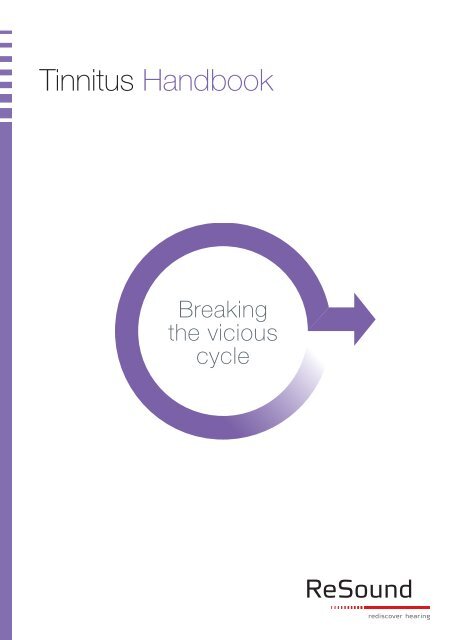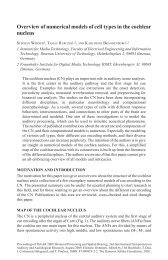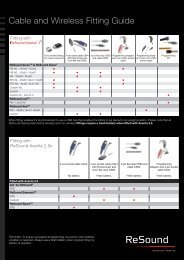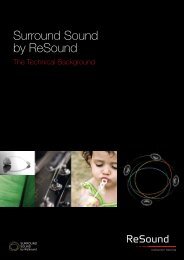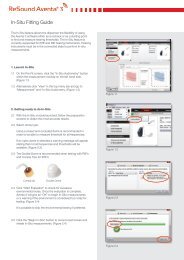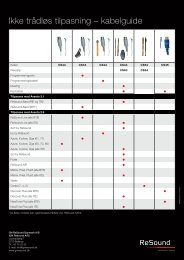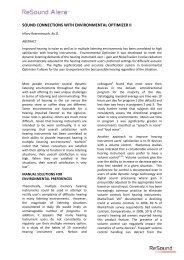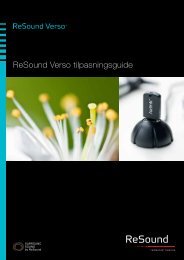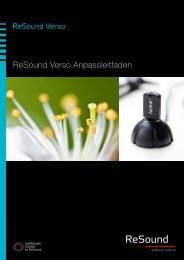Tinnitus Handbook - GN ReSound
Tinnitus Handbook - GN ReSound
Tinnitus Handbook - GN ReSound
Create successful ePaper yourself
Turn your PDF publications into a flip-book with our unique Google optimized e-Paper software.
<strong>Tinnitus</strong> <strong>Handbook</strong>This <strong>ReSound</strong> <strong>Tinnitus</strong> <strong>Handbook</strong> is designed to provide valuableinformation to those suffering from tinnitus. It will help you betterunderstand your tinnitus, and what can be done to assist you infinding some relief. If you have any questions, we strongly recommendthat you contact a hearing care professional who is qualified andexperienced in tinnitus management.Contents4 What is tinnitus?6 What causes tinnitus?8 The vicious cycle10 Is tinnitus real, and does it meanthere is something wrong with me?11 Can my tinnitus be cured?12 Who should I consult regarding my tinnitus,and what can they do for me?14 What treatment options are available?18 What is a tinnitus sound generator (TSG)?20 Will I always have to use the TSG?21 Is there anything I can do to help reduce my tinnitus?22 If there is no cure, what defines successfultinnitus treatment?24 Informational references
RESOUND TINNITUS HANDBOOKWhat is tinnitus?<strong>Tinnitus</strong> is a problem thatapproximately 10-15% of thepopulation reports experiencing ona regular basis. About a quarter ofthese suffer from a degree of tinnitussevere enough to seek medicalattention. These numbers are likely toincrease since tinnitus affects aboutone third of the population overage 65, and in industrial countries,noise pollutants and life span areincreasing.There are many different types oftinnitus. <strong>Tinnitus</strong> can vary in the wayit sounds, its severity, as well as itsannoyance. It is most commonlyreferred to as “ringing in the ears”.Individuals have reported anythingfrom intermittent episodes that arenot very bothersome to a constantnoise that can negatively influenceone’s daily life. <strong>Tinnitus</strong> takes manydifferent forms; for example, a ringingor chirping, “whooshing” or clickingsounds. It can occur a few times amonth or many times in one day. Itcan last for a few moments or severalhours, or it can be constant withoutrelief - even while people sleep. Forsome, tinnitus has a pulsating orrepetitive pattern.<strong>Tinnitus</strong> is generally accepted to havethree defining characteristics. First,tinnitus is a perception of sound andtherefore it must be audible to thepatient. Second, it is involuntary andcannot be produced intentionally.Third, it must originate inside thehead.You are not alone<strong>Tinnitus</strong> is actually heard by mostpeople at some point in their lives,even those with normal hearing.It can be a by-product of loudnoise exposure, such as a rockconcert or a night out at a club,disappearing after a few hours orthe morning after. It can also happenspontaneously without any reason,and then disappear as suddenly asit began. Many individuals believethis is just a function of the normalhearing system.However, when tinnitus starts tonegatively affect one’s life and impacton day-to-day functioning, it isnecessary to seek medical attention.Figure 110-15% of the population reportexperiencing tinnitus.3% suffer tinnitus to a degree severeenough to seek medical attention.4 5
RESOUND TINNITUS HANDBOOKWhat causes tinnitus?There are many neurophysiologicaltheories on the causes of tinnitus andsite of origin. No one theory has beendefinitively proven, but some havebeen studied more than others. Theintention of this handbook is not toreview all the theories and models,but rather to discuss one of themore generally accepted models ofthe origin of tinnitus. We have listedmany good references and websitesat the back of the handbook thatdiscuss them in detail.In addition to the neurophysiologicalfactors, there can also be psychologicalinfluences that play a rolein the perception of tinnitus. It isimportant to consider both of theseaspects when trying to find relief fromyour tinnitus.One model of tinnitus generationA well-accepted theory on tinnitusgeneration is that of spontaneousactivity in the hearing system. Thisactivity can even take place in theabsence of sound being heard.Some experts believe that damageto hair cells in the cochlea (inner ear)can help cause tinnitus.The cochlea consists of two types ofhair cells: Outer hair cells and innerhair cells. Hair cells are responsiblefor helping us hear and thentransmitting what we hear to thebrain to be processed into meaning.Inner hair cells, rather than outer haircells, are primarily responsible forsending what we hear to the brain,although outer hair cells do play arole in this process. Because of theirlocation, outer hair cells are moreexposed and are often damagedbefore inner hair cells.When the outer hair cells areFurthermore, the way a persondamaged, they are unable to carry experiences tinnitus, and the amountout their normal function. Part of their of attention paid to it, varies fromresponsibility is to prevent the inner person to person. If it is ignored,hair cells from sending sound signals the tinnitus takes a low priority andto the brain when there is no sound it “blends” into the background.to be heard. As a result, hair cells If it is prioritized, the tinnitus cancan spontaneously transmit signals increasingly become a focal point forto the brain that are amplified, or the patient. If this continues for anmade louder, by the hearing system. extended period of time, the brain willThe amplified sound can result in learn to focus on the tinnitus, evena perceived “ringing” sensation when other background sounds areknown as tinnitus, and is illustrated present.in Figure 2.Figure 2It is believed that tinnitus is amplified spontaneoussound, resulting in a “ringing” in the brain.6 7
RESOUND TINNITUS HANDBOOKThe vicious cycleChronic tinnitusThe vicious cycleContinual tinnitus can cause anxietyand stress in many individuals.Once this negative connection isestablished, a cycle can begin thataffects other regions of the brain,including the limbic system (whichis involved in processing emotions)and the autonomic nervous system(physical/bodily reactions). This iscommonly known as the viciouscycle (Figure 3). When tinnitus isperceived, it can prompt a numberof emotions, including fear, danger,unhappiness, etc. These can in turncause physical reactions such asanxiety and stress, thus reinforcingthe tinnitus and making the cyclerepeat itself.Increasedattention totinnitusBreakingthe viciouscycle<strong>Tinnitus</strong>ManagementBreakingtinnitusNegativereactionInitialappearanceof tinnitusIncreased awarenessof tinnitusThe wrong focusSome noises – like a rattle in a new car or a baby crying – attractone’s attention, sometimes for good reason, sometimes for bad.Figure 3The vicious cycle8 9
RESOUND TINNITUS HANDBOOKWho should I consultregarding my tinnitus, andwhat can they do for me?It is strongly recommended that youstart with a hearing care professionalwho is trained and experiencedin treating tinnitus patients. Theseprofessionals usually have in-depthtraining on different treatment optionsand will thoroughly discuss yourtinnitus problems with you.The aim of the first consultation is tobetter understand the history of yourtinnitus and can include discussionsregarding the onset, traumatic eventsthat may have induced the tinnitus,how bothersome your tinnitus is,characteristics of the tinnitus andhow the tinnitus is affecting you.It is important that you go into depthon these issues as this will help themto identify the direction best suited fortreating your tinnitus. In addition to aconsultation, many tinnitus expertswill ask you to fill out a questionnairein order to more clearly understandhow your tinnitus is affecting you.Hearing testsThere are some audiological(hearing-related) tests that maybe administered to provide moreinformation regarding how yourtinnitus sounds to you. For example,tests might shed light on the pitchof your tinnitus and how loud youperceive it. The test results can laterbe compared with other resultsduring the treatment process, andhelp monitor the status of yourtinnitus over time.Help from a network ofprofessionalsIn addition to hearing careprofessionals, many otherprofessionals can be of assistance.Specialists, such as Ear, Noseand Throat doctors (ENTs),otolaryngologists or otologists canrule out any medical complicationsthat could cause or contribute toyour tinnitus. Family doctors orGeneral Practitioners (GPs) canassist in providing informationregarding medications and a generalmedical history that may be useful inunderstanding your tinnitus better.A psychologist and/or psychiatristmay be involved in the treatment planas well, depending on your needs.They often help in more severe caseswhere the tinnitus is unbearable byproviding counseling and supportthat may be beyond the scope of ahearing care professional.As some studies have shown thathigh doses of sodium or caffeinecan increase the loudness level insome cases of tinnitus, consultinga dietician may be helpful. Andbecause stress can aggravatetinnitus, some tinnitus experts mayrefer you to massage therapists tohelp you to relax.A network of professionals workingtogether to help you find relief fromyour tinnitus can be very effectiveas each discipline offers uniqueexpertise and knowledge to facilitatethe treatment process.12 13
RESOUND TINNITUS HANDBOOKWhat treatmentoptions are available?There are a number of treatmentoptions available, each offeringdifferent explanations for how theycan be beneficial to someonesuffering from tinnitus. It is not ourintention to recommend a preferredmethod, as different treatment plansmay be more suitable for particularcases of tinnitus. It is, however,important to consider your individualneeds and expectations whenselecting the appropriate type oftreatment plan.Figure 4Sound Therapy can be introduced in manyways by means of everyday items includingTVs, radios, portable music players, fans andtable-top sound generators.One of the more well-knowntreatment plans is Sound Therapy,where the use of a tinnitus soundgenerating (TSG) device is thefocal point, and simply involves theintroduction of sound in connectionwith tinnitus treatment. In additionto a TSG device, other soundgenerators, such as sound pillows,radios, TV, etc. can be used to helprelieve the negative effects of tinnitus.Sound TherapyWith Sound Therapy, the TSGdevice is set at a volume at whichthe tinnitus is partially covered bythe sound generated by the TSGdevice. This helps reduce theperceived strength of the tinnitussignal by introducing backgroundnoise, making it more difficult toseparate the tinnitus from thebackground noise. The goal beingthat the tinnitus signal is reduced bythe noise generated from the TSG,making detection of the tinnitus bythe brain more difficult. Over time,less importance and priority is placedon the tinnitus as the brain becomeshabituated to it. And thus relief isachieved.<strong>Tinnitus</strong> Retraining TherapyAnother well-known treatmentplan is <strong>Tinnitus</strong> Retraining Therapy(TRT). In TRT, emphasis is placedon education, and how the brain isinvolved in the perception of tinnitus,as previously discussed. This canhelp you to better understand wheretinnitus comes from, as well as tounderstand the reactions producedby other mechanisms in the bodyin response to the tinnitus. Thegoal of TRT is to gain knowledgeand understanding of your tinnitus,and for you to have more controlover your emotions and reactionsto the tinnitus. Ultimately, you willplace less importance and priorityon the tinnitus which, in turn, willhelp you cope with the tinnitus moreeffectively. Sound Therapy is oftenincorporated into TRT to providea combined solution to tinnitustreatment.14 15
RESOUND TINNITUS HANDBOOKWhat treatment optionsare available?In addition to Sound Therapy andTRT, there are Progressive <strong>Tinnitus</strong>Management (PTM). PTM is similarto TRT regarding education, butuses a 5-step hierarchal approachthat addresses the needs fordifferent levels of tinnitus. Thereare also psychological models oftreatment. It is outside the scope ofthis handbook to discuss the varietyof psychological models that areavailable, but often a psychologicalapproach can be used in conjunctionwith other types of treatment, whenappropriate.The goal of all treatment plans isessentially the same, to break thevicious cycle, and the negativityassociated with the tinnitus. Aswith any treatment plan, it shouldbe understood that results taketime. Some immediate relief may beachieved, but ultimately the goal isto become more comfortable withthe tinnitus, realize it is not lifethreateningand, most importantly,that you are in control of yourresponses to it.New approaches to tinnitusmanagement are surfacing all thetime. It is, however, important toseparate management plans thatmake unproven claims from thosethat are based on evidence-basedpractice.Figure 5There is less priority and focus on a candle at a busy dinner table, where itblends into the background, than on a table in isolation, where it stands outand is more difficult to separate from the environment.16 17
RESOUND TINNITUS HANDBOOKWhat is a tinnitus soundgenerator (TSG)?A tinnitus sound generator is adevice like a hearing aid that deliverssound to the ear to help “cover up”the perceived tinnitus. TSG productscome in a variety of shapes andsizes, including devices that sit overthe ear, called behind-the-ear (BTE)hearing aids, as well as custommadeoptions that are designed toonly fit the unique contours of yourear. Just as hearing aid technologyhas improved over the years, so hasthe TSG technology available today.In addition, some newer technologyallows you to modify the noisegenerated by the device to providemore individualized, comfortablesettings for your particular needs.Some specialized TSG productseven offer a soothing “ocean wave”sound (think of waves rolling inand out) that can be more relaxingthan the traditional “‘white” noisegenerated by previous versions ofTSG products. Some TSG productseven have automatic functions, whichfurther help distract your attention onthe tinnitus by reducing interactionwith the hearing aid, making it easierfor you to get on with your dailyactivities without having to “fiddle”with controls on the device.Combination hearing devicesShould you also have a hearing lossthat needs to be treated, there areadvanced options called combinationdevices. Combination devices offeryou the unique flexibility of having a<strong>Tinnitus</strong> Sound Generator (TSG) andhearing aid all in the same compactpackage. This provides the flexibilityand convenience you and the hearingcare professional may be lookingfor, since you do not need separatedevices to treat two issues. There aredifferent levels of technology availablefor combination devices, dependingon what your particular needs are.Talk to your hearing care professionalabout what options may be mostappropriate for you.Figure 6Examples of combination devices.It is important to remember that TSGand combination devices are notcures. They are tools to be used inconjunction with an individualizedtreatment plan and good counseling.TSG and combination TSG/hearingaids can be very effective when usedappropriately, and with the righttreatment plan.18 19
RESOUND TINNITUS HANDBOOKWill I always have touse the TSG?Is there anythingI can do to help reducemy tinnitus?As mentioned before, tinnitusrehabilitation takes time. Remember,tinnitus itself does not cause harm,but rather it is your response tothe tinnitus that can affect your life.Learning to cope with your tinnitus isa process, and should be delicatelyhandled and treated over a period oftime.Some people find immediate reliefwhen using a TSG or combinationdevice, reporting that the devicehelps take the edge off the tinnitus.For others, it takes longer.The goal of a TSG or combinationdevice is to decrease the perceivedstrength of the tinnitus signal bypartially “covering up” the tinnituswith the noise generated by thedevice. This way, the tinnitus getsfiltered out at the sub-cortical level,just like unimportant daily soundslike the humming of a fridge. Whentinnitus sounds get filtered outrather than escalated, it is known ashabituation.Habituation takes timeOver time, it is expected thathabituation to the tinnitus will occur,and subsequently you can learn tolive comfortably with tinnitus.Studies have shown that for someTSG and combination devices, itcan take 6-24 months for completehabituation to take place andmaximum benefit to be achieved.Some individuals may require moretime for complete habituation tooccur. Again, it is very important tounderstand what works best for youand to work with the recommendedsuggestions of the hearing careprofessional while using a particularTSG or combination device.For most individuals there are noquick fixes to tinnitus, but there aresome lifestyle changes you can maketo help you manage your tinnitusbetter. Here are some recommendedtips that may be helpful:Good dietary and lifestyle habitsReducing consumption of sodiumand caffeine may help diminish theperceived strength of the tinnitussignal. In addition, the overall benefitsof moderate exercise can aid instress reduction, general health,sleep patterns, etc.Keep busyBy occupying your time with a varietyof enjoyable activities and engagingin tasks that require attention, lesstime may be spent focusing on thetinnitus.Avoid complete silenceBy adding some light backgroundnoise (e.g. music, TV), the strengthof the tinnitus signal will be reducedagainst the introduced backgroundnoise. This can also be useful duringquiet times or when trying to fallasleep.Wear hearing protectiononly when neededInappropriate use of hearingprotection can increase the sensitivityof the hearing system, making youmore aware of your tinnitus. Hearingprotection should only be usedwhen exposed to hazardous levelsof noise that could damage hearingand potentially make the tinnitusworse. Hazardous levels of noisecan damage and even destroy thehair cells in the inner ear. Greaterdamage to hair cells could intensifythe tinnitus.20 21
RESOUND TINNITUS HANDBOOKIf there is no cure, whatdefines successful tinnitustreatment?Success can be defined in manyways. As there is no known curefor tinnitus, any expectation ofcompletely eliminating the tinnitus ismost likely unrealistic. Therefore, youand the hearing care professionalshould only set goals that are realisticand achievable.To some, being able to provideany relief from tinnitus could beconsidered a success. Being able toperform daily activities without thestress and annoyance of tinnitus ona constant basis would be a greatrelief. Overall, most treatment plansagree that habituating to the tinnitusis the ultimate goal. Habituatingmeans that you will learn to acceptand cope with your tinnitus, giving itless importance and lower priority,allowing more freedom to focus onmore important matters in life.Measuring your progressAs discussed previously, thereare questionnaires that can helpquantitatively measure the progressof tinnitus treatment.Typically, these are given whenyou first visit the hearing careprofessional, providing baselinedata on your initial reactions to thetinnitus, and these tests can be giventhroughout treatment to measure theprogress of your treatment plan.The most important thing toremember is to start by finding ahearing care professional that istrained and experienced in treatingtinnitus patients. Together you candiscuss what your treatment optionsare and then decide what the bestplan of action is for your particularneeds.Remain positiveLast, but not least, always remainpositive. Severe tinnitus is extremelydifficult to live with, but there areprofessionals out there that canhelp you. Together you can find asuccessful solution.22 23
RESOUND TINNITUS HANDBOOKInformationalreferencesNotesAmerican <strong>Tinnitus</strong> Associationwww.ata.orgBritish <strong>Tinnitus</strong> Associationhttp://www.tinnitus.org.ukNew Zealand <strong>Tinnitus</strong> Associationwww.tinnitus.org.nzUnited States National Library of MedicineNational Institutes of Healthwww.nlm.nih.gov/medlineplus/tinnitus.html<strong>Tinnitus</strong> Retraining Therapywww.tinnitus.org<strong>Tinnitus</strong> Research Initiativewww.tinnitusresearch.orgOregon <strong>Tinnitus</strong> and Hyperacusis Treatment Center, Incwww.tinnitus-audiology.comUniversity of Iowa Health Care: <strong>Tinnitus</strong> Clinicwww.uihealthcare.com/depts/med/otolaryngology/clinics/tinnitus/index.html<strong>Tinnitus</strong> Practitioners Association (TPA)www.tinnituspractitioners.com24 25
RESOUND TINNITUS HANDBOOKNotes26 27
Worldwide headquarters<strong>ReSound</strong> A/SLautrupbjerg 7DK-2750 BallerupDenmarkTel.: +45 45 75 11 11Fax: +45 45 75 11 19www.resound.comM200594United Kingdom<strong>GN</strong> <strong>ReSound</strong> Ltd.1 Landscape CloseWeston Business ParkWeston-on-the-GreenOxon OX25 3SXTel.: +44 1869 352 800Fax: +44 1869 343 466www.gnresound.co.ukAustralia<strong>GN</strong> <strong>ReSound</strong> Pty. Ltd.Unit R1 Regents Park Estate391 Park RoadRegents Park NSW 2143Tel.: (free) 1800 658 955Fax: 02 9743 7472www.gnresound.com.auNew Zealand<strong>GN</strong> <strong>ReSound</strong> (NZ) Ltd.12 Parkway DriveMairangi BayAucklandTel.: (free) 0800 900 126Fax: (free) 0800 007 695www.gnresound.co.nzCanada<strong>GN</strong> <strong>ReSound</strong> Canada303 Supertest RoadToronto, OntarioCANADA M3J 2M4Tel.: +1 888 737 6863Fax: +1 800 666 4089canada@gnresound.comwww.gnresound.ca<strong>ReSound</strong> ® provides excellent sound by offering innovative hearingsolutions that combine original thinking and design with solidtechnology – all based on deep audiological insight and a profoundunderstanding of the hearing impaired.www.resound.com/tinnitus


